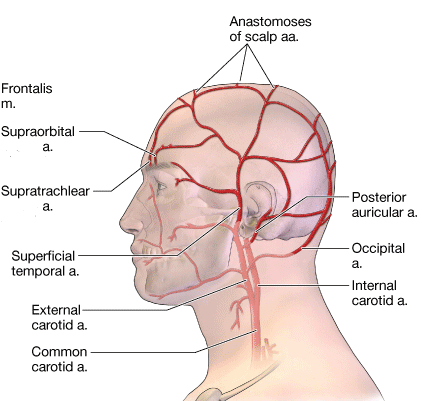Scalp
Vascular Supply
Five (5) pairs of arteries that supply the scalp.
The scalp is highly vascularized via branches of the external and internal carotid arteries.
- External carotid artery. Branches include the occipital, posterior auricular, and superficial temporal arteries.
- Internal carotid artery. Branches include the supraorbital and supratrochlear arteries.
Scalp lacerations usually bleed profusely, primarily because arteries enter the scalp and bleed from both ends of the artery as a result of abundant anastamoses. In addition, the severed arteries do not contract when they are cut because the vessel lumens are held open by the dense connective tissue in the second layer of the scalp. As a result, bleeding from the scalp can be profuse.
The supraorbital and supratrochlear veins unite to form the facial vein. The superficial temporal vein joins with the maxillary vein to form the retromandibular vein in the parotid salivary gland. The posterior auricular vein unites with the posterior division of the retromandibular vein to form the external jugular vein.
Scalp veins connect with the diploic and emissary veins.
- Diploic veins. Diploic veins course in the diploe cranial bones of the skull and connect with the dural venous sinuses via emissary veins.
- Emissary veins. Small veins connect veins of the scalp and skull with the dural venous sinuses.

